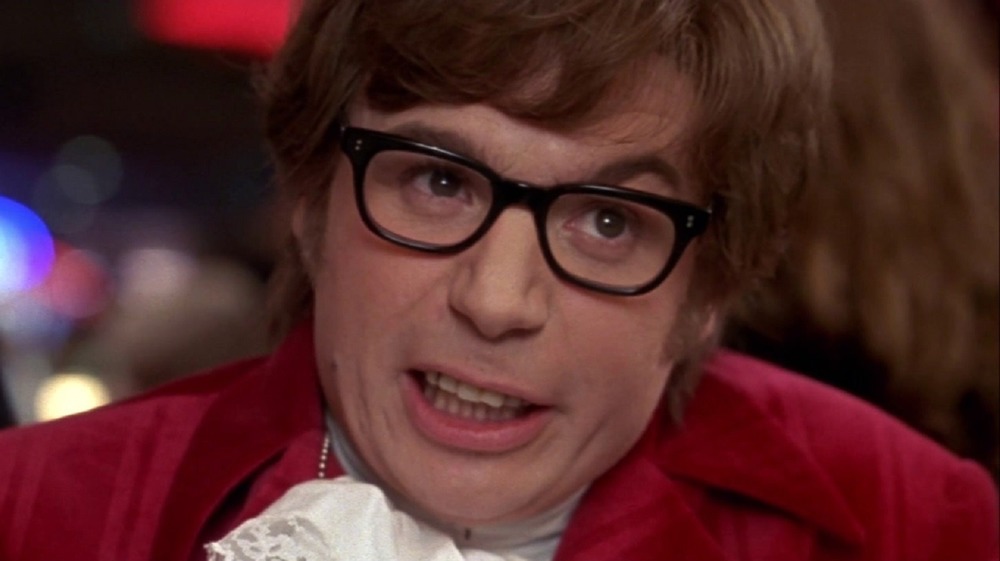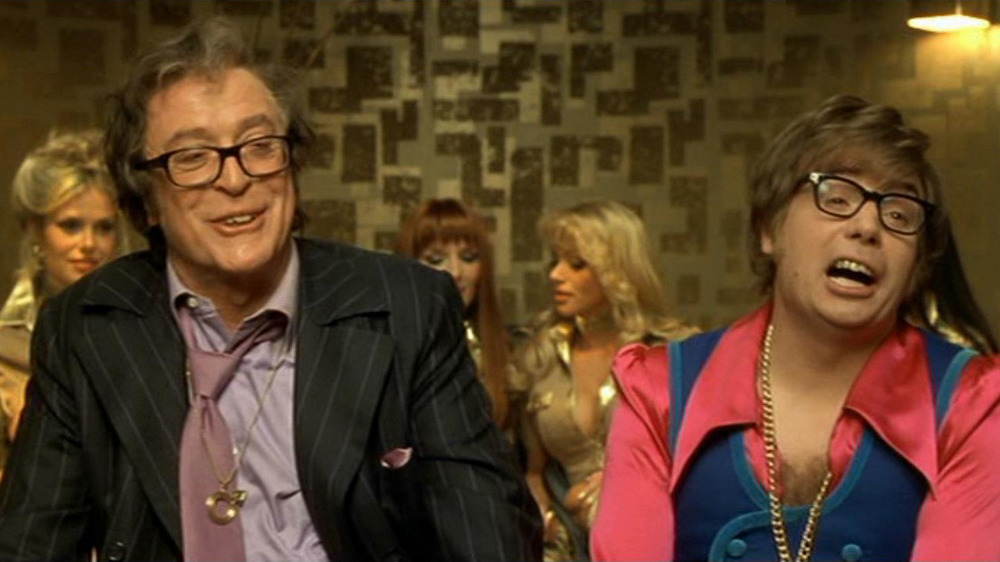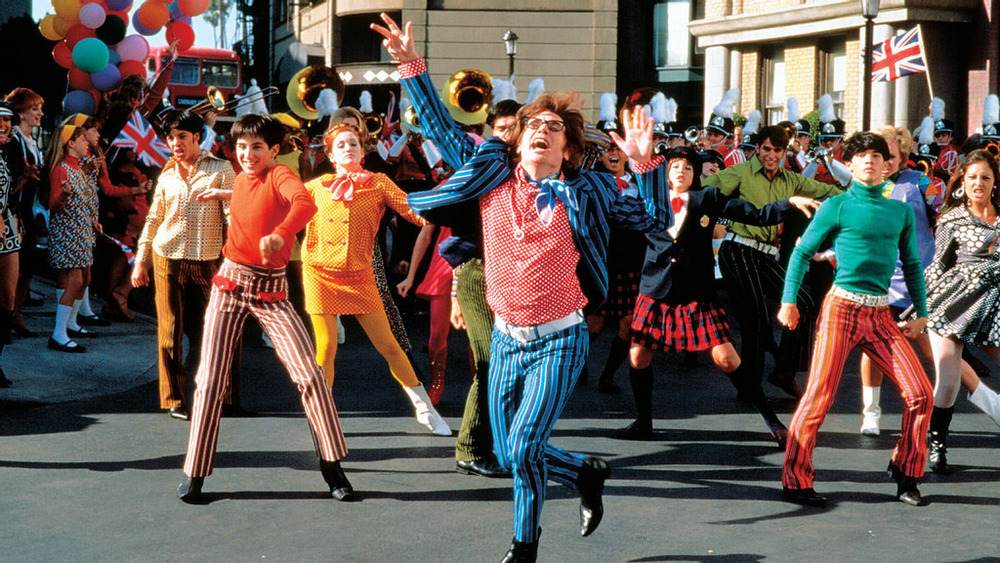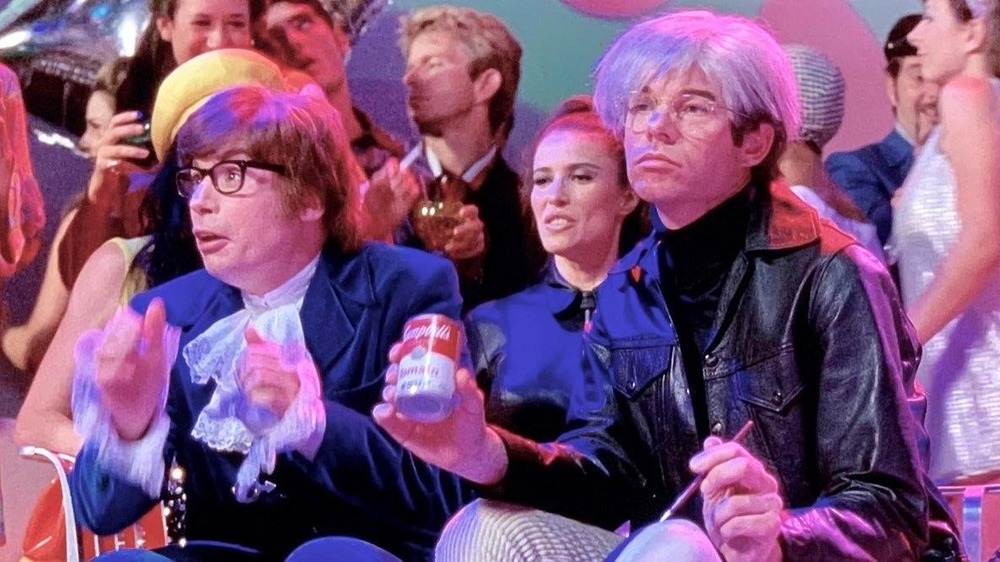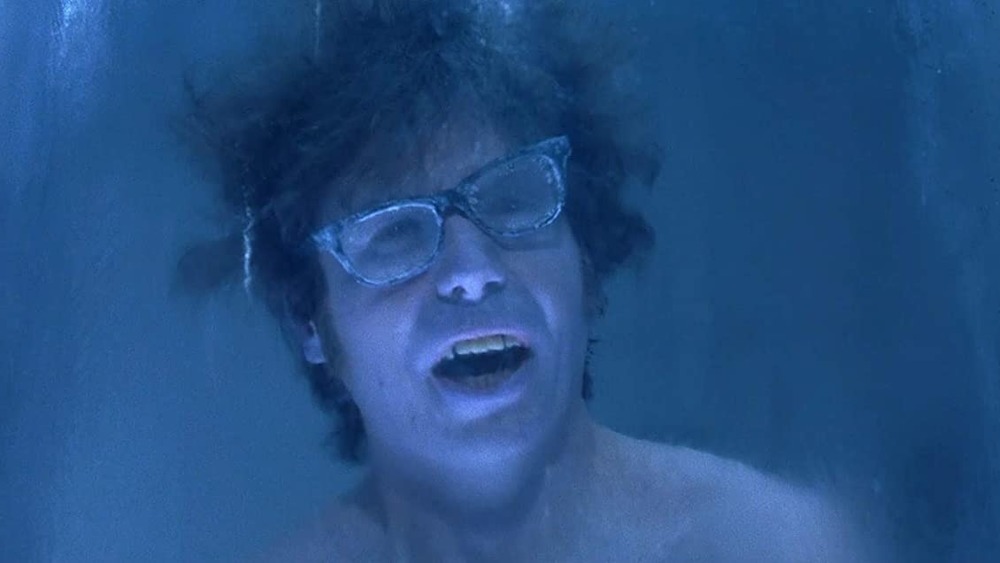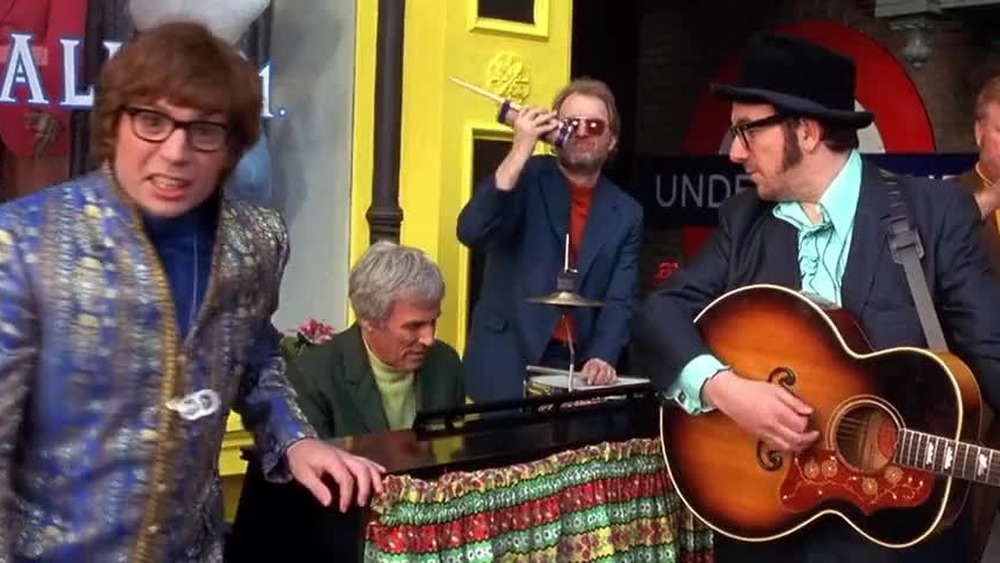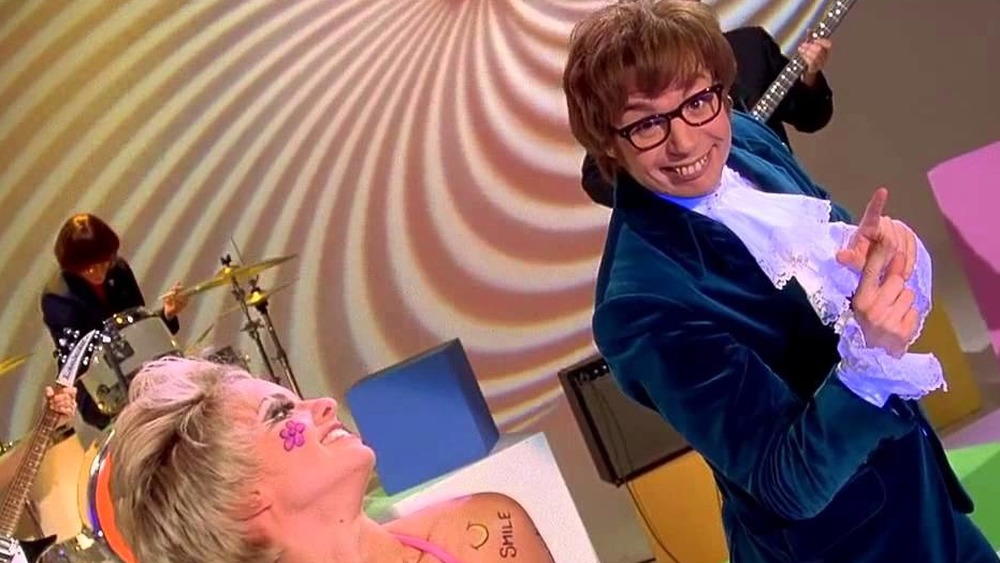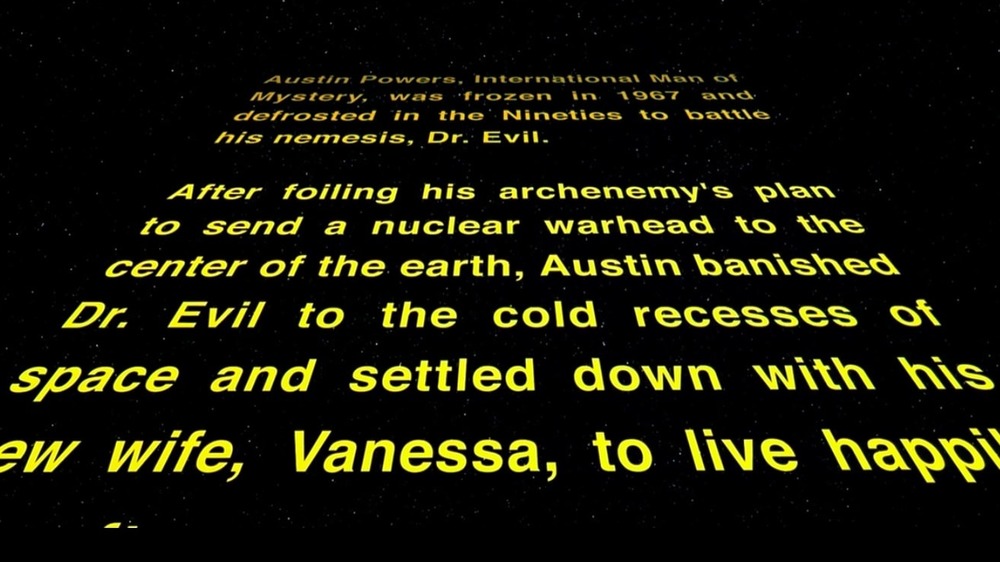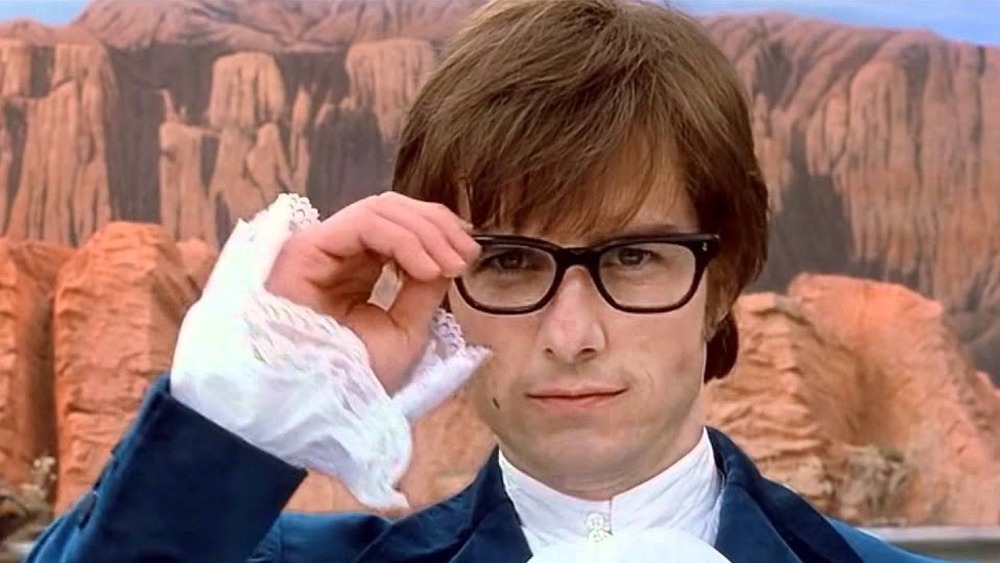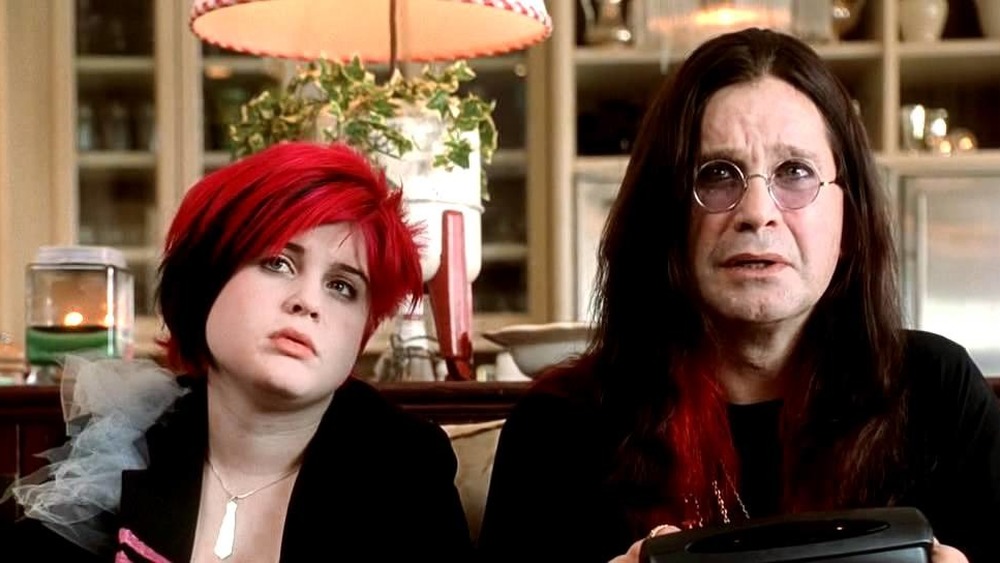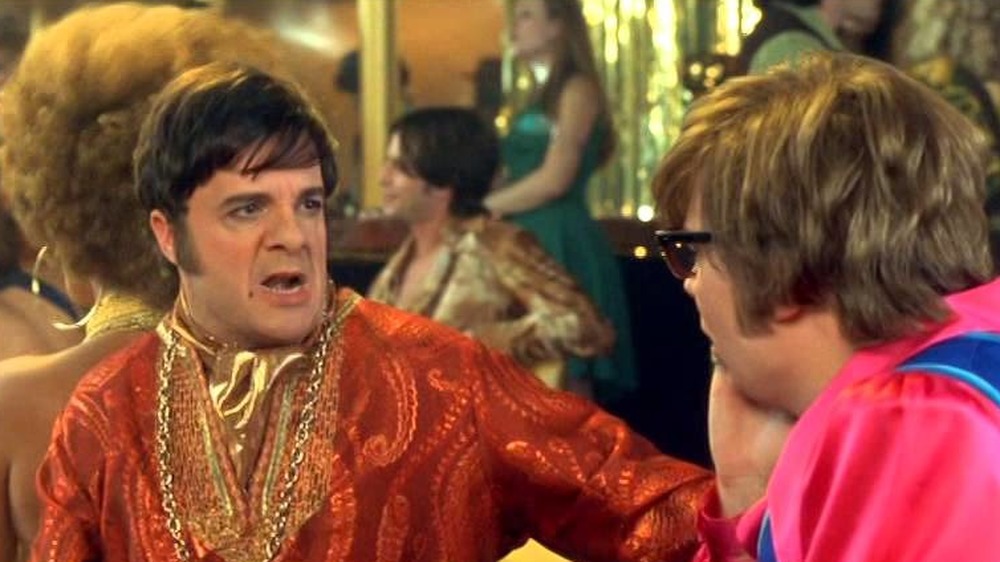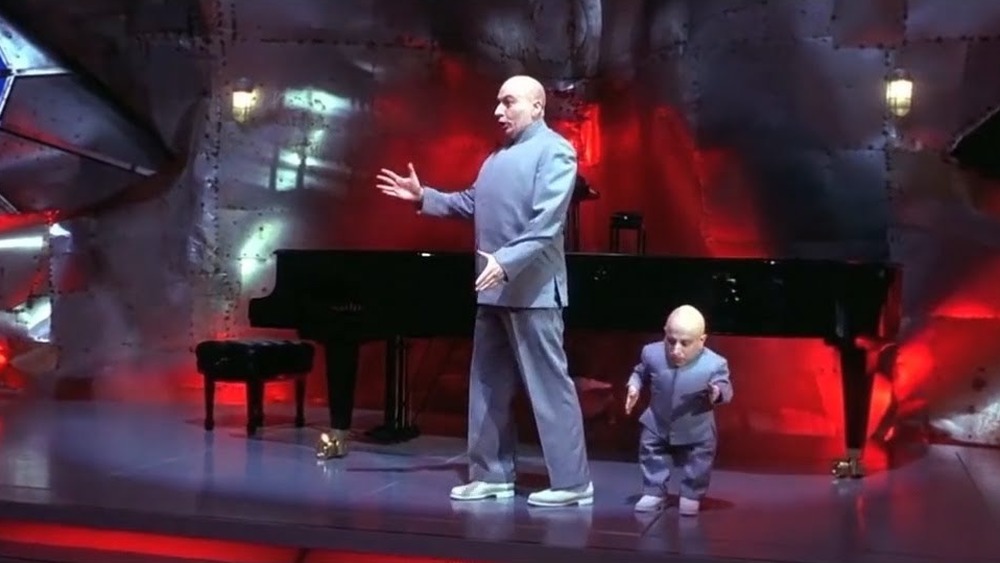Things You Forgot Happened In The Austin Powers Movies
Is there a film franchise that's groovier, randier, and more shagadelic than the time-hopping exploits of one Austin Powers? One would certainly hope not as, more than two decades on, the comedy world has never been able to reclaim the sense of hilarious thrills, nostalgic homage, and outright character lunacy that was so brilliantly captured by Mike Myers' gap-toothed, ribald British spy hero.
Maybe it's been quite a while since you've revisited any of the films in the Austin Powers trilogy directed by the incomparable Jay Roach, so perhaps it's fair to say that there's quite a bit you might've forgotten since your first encounters with Dr. Evil, Mini-Me, and the rest of Austin's groovy cast of characters. If so, hop into the Shaguar and get your groove on because we're going to take a look at all the things you forgot happened in the Austin Powers movies! Yeah, baby!
The Austin Powers films are an ode to father/son relationships
Mike Myers has spoken on numerous occasions about how the character of Austin Powers was inspired by the pop culture he shared with his own late father. Growing up, the two watched British films from the 1960s and listened to music from that era, and as a result, the father and son formed a bond that Myers hoped to carry into the onscreen life of his raunchy British spy.
That love for his dad isn't just built into the aesthetics of the films, but it's also a major thematic element of all three movies. For example, Dr. Evil's (Myers) burgeoning relationship with his long-lost son, Scott (Seth Green), provides major emotional and humorous material for every film in the trilogy. But it's Goldmember – where we're introduced to Austin's forever absent spy father, Nigel Powers (Michael Caine) — where themes of fatherly love and familial acceptance are truly cemented as the beating heart of this admittedly silly franchise.
Each film's opening dance sequence is crazier than the last
Even when some of the Austin Powers films don't always live up to the potential of the franchise as a whole, it's undeniable that the high watermark of each movie is the grand opening number. Each installment launches into a dance sequence that catapults the tone and style of these films right into our laps in a garish and undeniably joyous fashion.
Using Quincy Jones' certified '60's bop that is "Soul Bossa Nova," each film builds upon the previous entry's lunacy, with the first film using the sequence as a means of introducing us to the mania-inducing sexual appeal of Austin, launching a Beatles-like frenzy wherever he goes. This is only topped by The Spy Who Shagged Me's nude dance sequence through a hotel, eventually transforming into a full-on Busby Berkeley-inspired swimming pool number. And then there's Goldmember's Hollywood backlot tour, which moves through a combined Singin' in the Rain/The Umbrellas of Cherbourg tribute, runs into Quincy Jones himself, and eventually involves a ridiculous Britney Spears cameo, with an ending as outlandish as anything in the Powers-verse.
The first film's garish ode to the 1960s includes a surprise cameo
The time-hopping mania of the Austin Powers series throws us on a whiplash journey throughout the late 20th century and early 21st century, as Austin and company zip from the '60s to the '90s and back again, with some detours in the '70s and 2000s just to keep us on the edge of our seats. But it's all tied back to that original 1967 start date, where we first meet Austin in his pure, ideal element as the swinging super spy that the ladies love.
However, Powers isn't the only character we meet who just radiates the hip and happening '60s. Popping up in the Electric Psychedelic Pussycat Swinger's Club to add to the film's 1960s aura is a figure who looks an awful lot like the boundary-pushing visual artist Andy Warhol. And yeah, he appears to be having a characteristically droll time in the middle of all the partygoers. It's a fun gag to find amidst a colorful and eclectic environment, hooking us into the franchise's vibe right from the get-go.
Austin Powers is frozen alongside some fellow celebrities
As Dr. Evil hurls forwards into the future in Austin Powers: International Man of Mystery, frozen within his satellite Big Boy statue that's floating in orbit around the Earth, British Intelligence knows that only Austin Powers has the power to journey decades into the future to take down his villainous arch-enemy. That involves putting the super spy on ice, allowing him to bring his mojo with him to the late '90s, providing a shocking contrast between the '60s spy and his modern surroundings.
Upon his unfreezing in the present day of 1997, one of the more humorous — and admittedly, more forgettable — gags is the frozen company that Austin is keeping, where fellow celebrities Gary Coleman and Vanilla Ice have inexplicably been frozen, as well. Whether it was their choice or against their will is a completely different rabbit hole to go down, but it's certainly a fun tidbit to catch on a rewatch.
Burt Bacharach is a running gag in the Austin Powers films
The Austin Powers films are indebted to the pop culture of the 1960s, from the music of Quincy Jones to the films of James Bond and Michelangelo Antonioni to the art styles of Andy Warhol and Roy Lichtenstein. And adding to that impeccable '60s flavor of the series is legendary tunesmith and pop sensation Burt Bacharach, composer of such hits as "Raindrops Keep Falling On My Head" and "I Say A Little Prayer," among other glorious standards.
Bacharach lends his musical stylings and his own visage to the series, providing cameo appearances to underscore Austin's respective romantic endeavors in each film. In The Spy Who Shagged Me, he's even joined by contemporary songsmith Elvis Costello in a glorious cover of one of Bacharach's most memorable standards, "I'll Never Fall in Love Again."
You probably forgot about those weird '60s segues
The success of the Austin Powers films isn't just their ribald humor and cartoonishly maniacal characters (okay, those are huge parts of why they're successful, but nevertheless). The films have been crafted in such a way that they're stylistically daring, visually memorable, and a satisfying cinematic send-up/homage to the decade of culture they love so much.
A huge part of keeping up that bizarre '60s energy is the odd connective tissue that allows audiences to segue from scene to scene. This crazy little musical numbers show up in the first two films — hypnotic, blink-and-you'll-miss-them interstitial scenes of Austin dancing the night away with his bodacious hippie brethren against a backdrop of pastel colors. It could be considered a minor detail, one so small you might've forgotten about it, but these groovy moments give the films that extra flavor of cinematic goofiness that keeps things moving right along.
The second film opens with a Star Wars parody
It's hard to say if, when making the original Austin Powers film, Mike Myers, Jay Roach, and the rest of the creative team had any idea what kind of a cultural phenomenon their groovy British super spy comedy would become, but after Austin and Dr. Evil became household names practically overnight, the game was changed. As a result, the inevitable sequel had to live up to the inevitable hype.
So, naturally, when coming up with their shagadelic sequel, they had to pull out all the stops. And as the film was premiering just weeks after the release of the newest Star Wars movie in decades, The Phantom Menace, what better way to jump back into the pop cultural zeitgeist than paying homage to that summer's other franchise blockbuster? The film opens up with a parody of the classic Star Wars title crawl, and the bit comes to play later in the film when Dr. Evil makes a Darth Vader-esque joke about being Austin's father, though Goldmember would prove that their familial ties aren't as distant as they think.
You might've forgotten the fake movie in Goldmember
It's been almost 20 years since Austin Powers in Goldmember, the third — and at this point, final — entry in the epic Austin Powers saga. And after the smashing success of the second film, this entry starts in the most bombastic way possible — with a car chase through the desert, an exploding helicopter, and Austin Powers flipping through the air shooting bullets at a ludicrous rate.
If the action seems a bit too over the top, even for an Austin Powers film, it's revealed that this is a classic Hollywood take on the Powers story. In a hilarious joke, it turns out that Steven Spielberg has turned the spy's life into a movie within the movie, one starring Tom Cruise (naturally) as the International Man of Mystery himself. He's joined by Gwyneth Paltrow as his love interest, one named — of course — Dixie Normous. Plus Kevin Spacey and Danny DeVito show up as, respectively, Dr. Evil and Mini-Me (Verne Troyer). It's a grand adaptation that honestly sounds like something worth checking out.
Some of Austin Powers' raunchiest segments feature hilarious celebrity cameos
The Austin Powers films love their crude, raunchy humor. They also love getting celebrities in on the joke. After all, what's funnier than having some of your favorite stars make cracks about male genitalia?
For example, take the extended gag in The Spy Who Shagged Me, when Dr. Evil launches a rocket that's shaped like a huge, well, you know. As people around the world marvel at the phallic weapon soaring above the planet, we're treated to several cameos ... of famous stars whose first names all double as euphemisms. For example, there's, uh, Willie Nelson and Woody Harrelson, both gawking at the genitalia-shaped weapon passing by.
The gag comes back around in Goldmember, and this time, the Osbourne family shows up. Only the rocker and his clan aren't too happy about it, and they break the fourth wall, criticizing the third Austin Powers movie for lazily reusing the joke and dragging them into it. But while they may call it lazy, we think these randy little cameos are pretty hilarious.
Some well-known names play minor roles in the Austin Powers movies
The Austin Powers film feature a ton of celebrities playing themselves, but on top of that, there's a plethora of cameos from actors playing outsized characters and delivering a whole heap of fun crammed into their limited screen time. Starting with the first film, there's an oft-forgotten cameo by Carrie Fisher as a group therapist for the father-son therapy group where Dr. Evil and Scott try and fail to reconcile their relationship.
Then, there's the trilogy-spanning Clint Howard as Radar Operator Johnson Ritter, who helps to set into motion some of the film's most infamous — and humorous — sequences. There's also Fred Savage as the sneaky mole who, of course, has a huge mole on his face, and Nathan Lane pops up as the Disco Man, acting as Foxxy Cleopatra's (Beyonce) messenger in Goldmember. All these comedians provide top-notch performances in films already brimming with comic potential.
Dr. Evil and Mini-Me have musical numbers in Goldmember
Verne Troyer's Mini-Me, a pint-sized clone of Dr. Evil, became an overnight sensation after the release of The Spy Who Shagged Me. This was hammered home not just by the film's frantic use of his miniscule size for comedic purposes but because Troyer threw himself (sometimes literally) into the role, performing what could've been a ridiculous one-off gag with the seriousness and commitment that makes comedic performances so outstanding.
This extends to a strange motif of Dr. Evil and Mini-Me's relationship — performing in outlandish musical numbers just for the heck of it. In The Spy Who Shagged Me, the dynamic duo performs a charmingly silly rendition of "Just the Two of Us," where, indeed, they can make it if they try. And in Goldmember, after they're both sent to prison, Dr. Evil and Mini-Me perform an odd (to say the least) rendition of Jay-Z's "Hard Knock Life (Ghetto Anthem)," two numbers that convey the absolute absurdity of Dr. Evil and Mini-Me's relationship.
